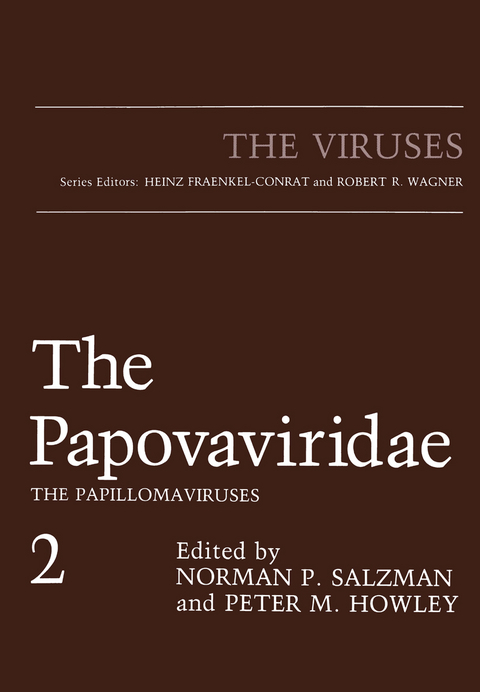
The Papovaviridae
Springer-Verlag New York Inc.
978-1-4757-0586-7 (ISBN)
1 Papillomaviruses: General Description, Taxonomy, and Classification.- I. Introduction.- II. Properties of the Virions.- III. Biological Properties.- IV. Classification and Nomenclature.- V. Description of Virus Types.- VI. Evolutionary Aspects.- References.- 2 Animal Papillomas: Historical Perspectives.- I. Canine Oral Papillomatosis.- II. Shope Rabbit Papilloma.- III. Equine Papillomatosis.- IV. Bovine Papillomatosis.- V. Papillomatosis in Sheep.- VI. Oral Papillomatosis of Rabbits.- VII. Deer Fibromatosis.- VIII. European Elk Papillomaviruses.- IX. Viral Papillomatosis in Other Animals.- References.- 3 Organization and Expression of Papillomavirus Genomes.- I. Introduction.- II. General Properties of Papillomavirus Genomes.- III. The Genome of BPV-1.- IV. Comparative Anatomy of Papillomavirus Genomes.- V. Predicted Functions of Papillomavirus Proteins.- VI. Transcriptional Organization of Papillomavirus Genomes.- VII. Conclusions.- References.- 4 The Expression of Papillomaviruses in Epithelial Cells.- I. Introduction.- II. Epithelium and Keratinization.- III. Behavioral Classification of PVs.- IV. Histological Characteristics of PV-Induced Lesions.- V. Transformation.- VI. Vegetative Viral Growth.- VII. Cytopathic Effects.- VIII. Expression of PV in Cultured Keratinocytes.- IX. Expression of PV in Malignant Cells.- X. Conclusions.- References.- 5 Papillomavirus Transformation.- I. Introduction.- II. Transformation Biology.- III. Transcription.- IV. Transforming Functions.- V. Plasmid Maintenance Functions.- VI. Summary and Conclusions.- References.- 6 Papillomaviruses and Carcinogenic Progression I: Cottontail Rabbit (Shope) Papillomavirus.- I. Introduction.- II. Biological Properties of the System.- III. Molecular Aspects of the System.- References.- 7 Papillomaviruses and Carcinogenic Progression II: The Mastomys natalensis Papillomavirus.- I. The Animal System.- II. Epithelial Skin Tumors in Mastomys.- III. Identification of MnPV as the Causative Agent of Skin Tumors.- IV. Characterization of the Virus.- V. Persistence of MnPV Genomes in Normal Tissues.- VI. Accumulation of Viral DNA in Normal Skin during Aging.- VII. MnPV Genome Expression in Tumors.- VIII. Induction of MnPV by Tumor Promoters.- IX. Induction of Antibodies against MnPV in Mastomys.- References.- 8 Epidermodysplasia Verruciformis.- I. Introduction.- II. Clinical Aspects of EV.- III. Histology and Ultrastructure of EV Lesions.- IV. Genetic Factors in EV.- V Immunological Factors in EV.- VI. HPV Types Associated with EV.- VII. Role of HPVs in EV Carcinomas.- VIII. HPVs and Skin Neoplasia in Non-EV Patients.- IX. In Vitro Studies on EV HPVs.- X. Questions Raised by EV.- References.- 9 The Role of Papillomaviruses in Human Anogenital Cancer.- I. Introduction and Historical Aspects.- II. Isolation of Genital Papillomaviruses and Their Characterization.- III. Biology of Genital Papillomavirus Infections.- IV. HPV DNA Sequences in Cell Lines.- V. State of Viral DNA in Benign and Malignant Lesions.- VI. Interaction of Papillomavirus Infections with Initiators in Malignant Conversion.- VII. Association of Malignant Tumors with Genital Papillomavirus Infections at Extragenital Sites.- References.- 10 Laryngeal Papillomas: Clinical Aspects and in Vitro Studies.- I. Introduction.- II. Clinical Description.- III. Treatment.- IV. Pathology.- V. Molecular and Cellular Biology.- VI. Laryngeal Papillomas and Laryngeal Cancer.- VII. Major Unanswered Questions.- References.- 11 Papillomavirus Cloning Vectors.- I. Introduction.- II. Transformation by Bovine Papillomavirus.- III.Development of BPV-1 Vectors.- IV. Expression of Genes Cloned on BPV-1.- V. Stability of BPV-1 Recombinants.- VI. Future Directions.- References.- Appendix Sequence Analysis of Papillomavirus Genomes.- Carl C. Baker.- I. Papillomavirus Sequences.- II. Restriction Site Analysis.- III. Genome Organization.- IV. Protein Comparisons.- A. E1 ORF.- B. E2 ORF.- C. E4 ORF.- D. E5 ORF.- E. E6 ORF.- F. E7 ORF.- G. L1 ORF.- H. L2 ORF.- References.
| Reihe/Serie | The Viruses |
|---|---|
| Zusatzinfo | 113 Illustrations, black and white; 408 p. 113 illus. |
| Verlagsort | New York, NY |
| Sprache | englisch |
| Maße | 170 x 244 mm |
| Themenwelt | Medizin / Pharmazie ► Medizinische Fachgebiete ► Mikrobiologie / Infektologie / Reisemedizin |
| Studium ► Querschnittsbereiche ► Infektiologie / Immunologie | |
| Naturwissenschaften ► Biologie ► Botanik | |
| Naturwissenschaften ► Biologie ► Mikrobiologie / Immunologie | |
| Naturwissenschaften ► Biologie ► Ökologie / Naturschutz | |
| Naturwissenschaften ► Biologie ► Zoologie | |
| ISBN-10 | 1-4757-0586-7 / 1475705867 |
| ISBN-13 | 978-1-4757-0586-7 / 9781475705867 |
| Zustand | Neuware |
| Haben Sie eine Frage zum Produkt? |
aus dem Bereich


